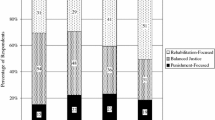Abstract
For over four decades, national legislation has supported efforts to move persons with severe and persistent mental illness out of restrictive hospital settings and into community based services. Within institutional walls, numerous duties of state have been established to help ensure humane and effective treatment. However, the legal protections afforded hospitalized residents have not appeared to follow these individuals into the community. This article analyzes relevant case law and attempts to establish similarities between the state hospital's duty to protect its residents and the responsibility of community mental health centers to do the same for the persons they serve. The authors argue that the client's right to freedom-from-harm must receive increased attention and community based service providers will have to enhance their capacity to deliver more effective risk management services if mental health reform is to become a successful social policy.
Similar content being viewed by others
REFERENCES
Alexander, R. (1993). The legal liability of social workers after DeSchaney. Social Work, Vol. 38, Number 1, January, 64–68.
Board of Regents v. Roth, 408 U.S. 564 (1972).
Bullis, R. K. (1990). Cold comfort from the Supreme Court: Limited liability protection for social workers. Social Work, Vol. 35, Number 4, July, 364–366.
Canterbury v. Spence, 409 U.S. 1064 (1972).
Clark v. Cohen, 794 F. 2d (1986).
Costello, J. C. &; Preis, J. J. (1987). Beyond least restrictive alternative: A constitutional right to treatment in the community. Loyola of Los Angeles Law Review, June, 1527-1557.
DeShaney v. Winnebago County Department of Social Services, 812 F 2d 298 (7th Cir., 1987).
Dixon v. Weinberger, 405 F. Supp. 974 (D.D.C., 1975).
Estate of Bailey v. County of York, 768 F.2d 503 (3rd Cir. 1985).
French, L. (1987). Victimization of the mentally ill: An unintended consequence of deinstitutionalization. Social Work, Nov-Dec, Vol 32(6), 502–505.
Herr, S. S., Arons, S., &; Wallace, R. E. (1983). Legal rights and mental health care. Lexington, Mass.: Lexington Books.
Jensen v. Conrad, 747 F. 2d, 185 (4th Cir., 1984).
Johnson v. Solomon, 485 F. Supp. 278 (D. Md., 1979).
Lake v. Cameron, 267 F. Supp. 155 (D.D.C., 1967) Martinez v. California, 444 U.S. 277, (1980).
Mechanic, D. &; Rochefort, D. A. (1990). Deinstitutionalization: An appraisal of reform. Annual Review of Sociology, 16, 301–327.
Mechanic, D. (1999). Mental health and social policy. Boston: Allyn and Bacon.
New York State Association for Retarded Children v. Rockefeller 357 F. Supp. 752 (1973).
Rapp, C. A. &; Moore, T. D. (1995). The first 18 months of mental health reform in Kansas. Psychiatric Services, Vol. 46, No. 6, 580–585.
Rapson, R. (1981). The right of the mentally ill to receive treatment in the community. International Journal of Law and Psychiatry, Winter-Spring, 13-34.
Rose, S. (1987). A State's duty to develop community-based mental health treatment. The Journal of Contemporary Health Law and Policy, Spring, 281-308.
Seicshnaydre, S. (1992). Community mental health treatment for the mentally ill-when does less restrictive treatment become a right? Tulane Law Review, June, 1971-2001.
Stiles, P. G., Culhane, D. P., &; Hadley, T. R. (1996). Before and after deinstitutionalization: Comparing state hospitalization utilization, staffing, and costs in 1949 and 1988. Administration and Policy in Mental Health, 23 (6), 513–525.
Talbott, J. A. (1979). Deinstitutionalization: Avoiding the disasters of the past. Hospital and Community Psychiatry, 30 (9), 621–624.
Thomas S. v. Morrow, 781 F.2d 367 (1987).
Torrey, E. F. (1997). Out of the shadows. New York: John Wiley &; Sons, Inc.
Weed, J. (1987). The Third Circuit Widens the Scope of Section 1983: Estate of Bailey v. County of York. Journal of Contemporary Law, Vol. 32:285, 297–311.
Winchenbach, L. (1989). Snake pits and slippery slopes: DeShaney Revisited. ABA Journal, September, 62-65.
Wyatt v. Stickney, 325 F. Supp. 373 (1974).
Youngberg v. Romeo, 457 U.S. 307, 322 (1982).
Author information
Authors and Affiliations
Rights and permissions
About this article
Cite this article
Marty, D.A., Chapin, R. The Legislative Tenets of Client's Right to Treatment in the Least Restrictive Environment and Freedom from Harm: Implications for Community Providers. Community Ment Health J 36, 545–556 (2000). https://doi.org/10.1023/A:1001952717471
Issue Date:
DOI: https://doi.org/10.1023/A:1001952717471




